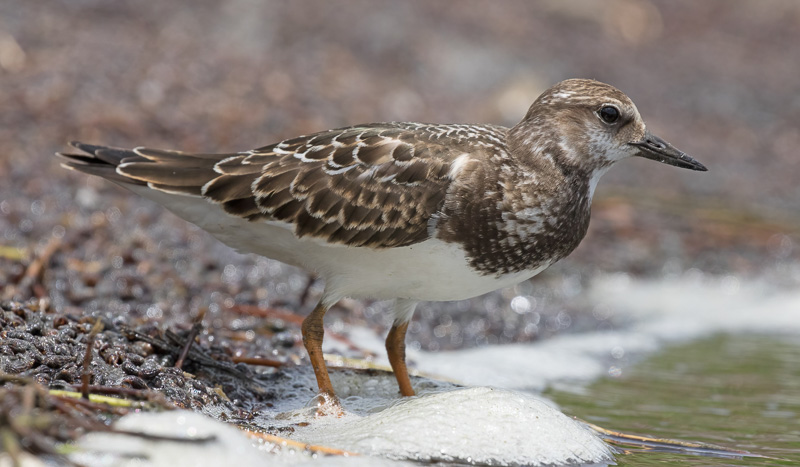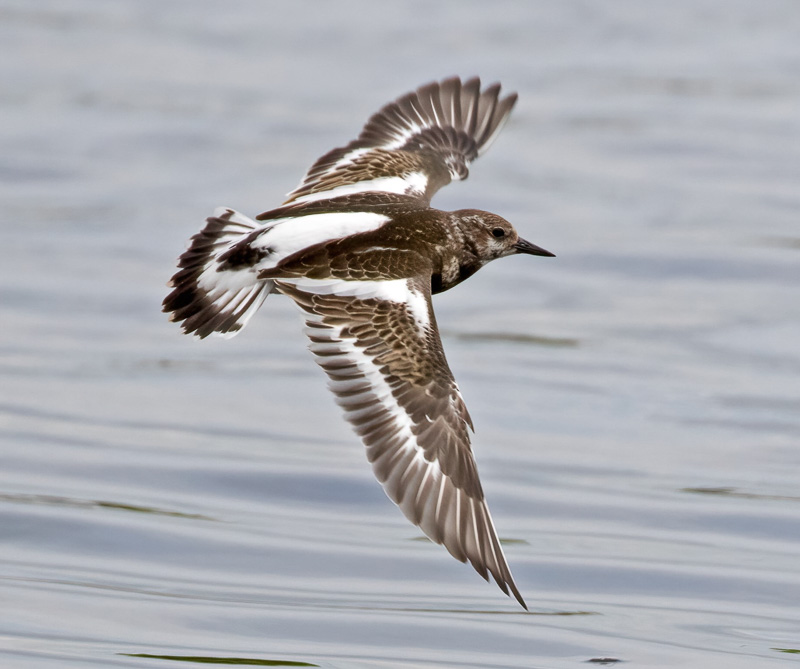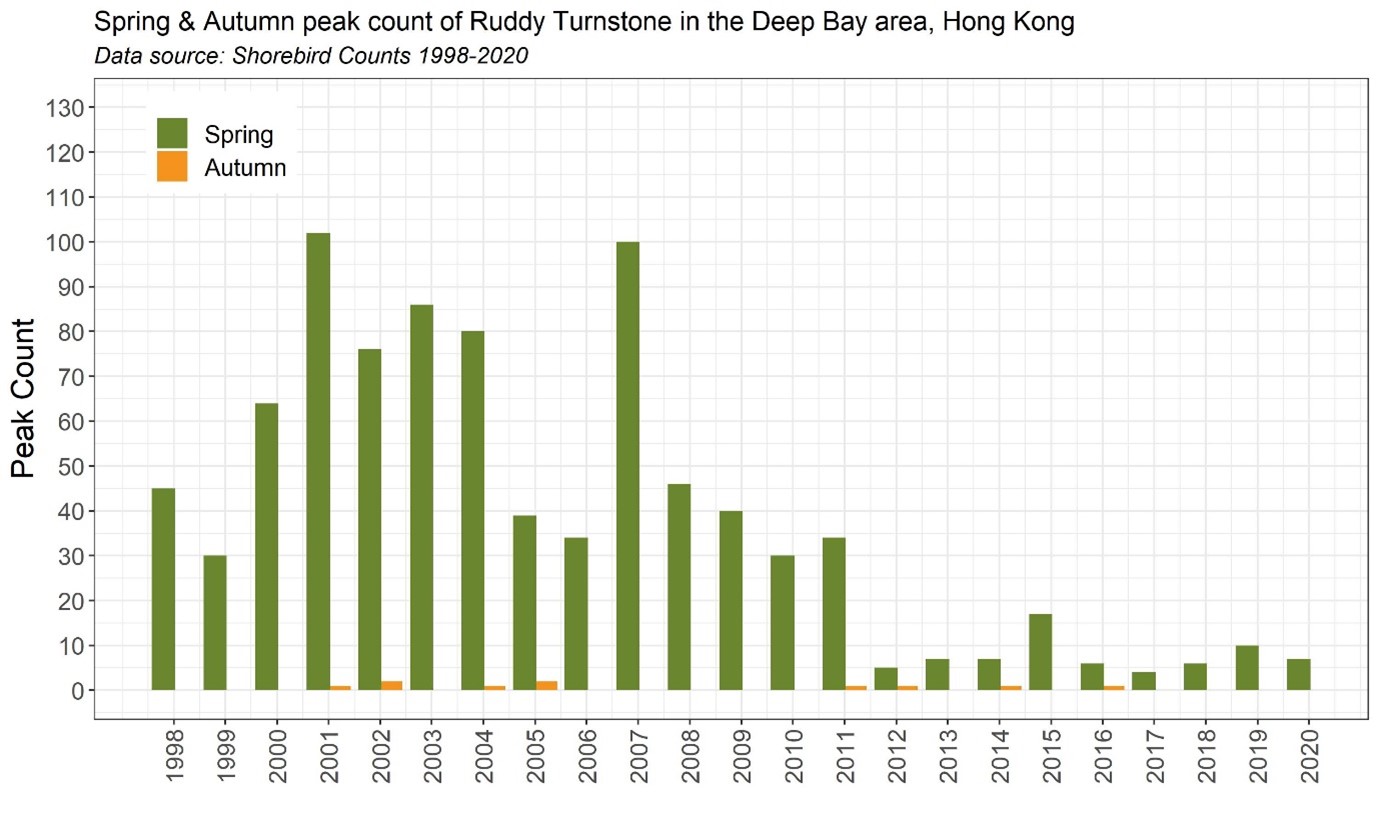Ruddy Turnstone Arenaria interpres 翻石鷸
Category I. Passage migrant, uncommon in spring and scarce in autumn; rare in winter.
IDENTIFICATION

Apr. 2019, Michelle and Peter Wong. Adult, breeding plumage.
21-26 cm. Very distinctive appearance. Squat, short-legged wader with short pointed bill, orange legs and distinctive black and white pattern in flight. Adult in breeding plumage has black and white head pattern, orange on scapulars and wing coverts and white underparts.

Sep. 2022, Dave Bakewell, Sarawak, Malaysia. Juvenile.
Adult in non-breeding plumage have a similar pattern to breeding plumage but are instead dull grey-brown with pale patches at sides of the chest. Juveniles can be distinguished by well-marked pale fringes to the upperparts and wing coverts.

Sep. 2022, Dave Bakewell, Sarawak, Malaysia. Juvenile. Distinctive pattern of white and dark (black on adults, brown on juvenile) in flight. |
VOCALISATIONS
The two typical flight calls are a ‘tyoo’ or ‘ch-tyoo’ and a rich short rattle.
DISTRIBUTION & HABITAT PREFERENCE
Most records are from the intertidal mudflats of Deep Bay and adjacent roosting areas, primarily Mai Po NR. Elsewhere, at the former airport at Kai Tak up to nine birds were noted during 1975-79, up to eight have been noted on Po Toi and seven on Tung Ping Chau; also recorded at Cape D’Aguilar, Kung Chau, Long Valley, Nai Chung, Shek O, Shui Hau and on The Brothers. Most of these records occur in spring.
OCCURRENCE
Ruddy Turnstone is now an uncommon spring migrant, a scarce autumn migrant and rare winter visitor (Figure 1). It was formerly more numerous on northward passage.
Spring passage is generally in evidence by the final week of March, with the earliest such record on 22 March 2016; earlier records are considered to relate to wintering birds. In the period since 1999 no more than 12 birds have been recorded up to the end of the third week in April. Peak passage occurs during the last week of April and first half of May, though the highest count since 1999 is 102 on 20 April 2001; this compares with the highest ever counts of 268 on 20 April 1994, 256 on 8 May 1993 and 250 on 2 May 1995, three years that witnessed consistently high numbers of Turnstones on spring passage. The latest spring record is of one on 13 June 1987.
The earliest autumn record occurred at Kai Tak on 3 August 1979. Passage is rather weak with the highest count only eight, on 24 September 1983 and 19 September 2005. Typically, it has ceased by early November, but up to 40 birds were recorded during 2-26 November 1991. Up to two Turnstones have been recorded in six winter periods, but none since 15 January 2012. The only record of juveniles is of two on 1 October 1994.
Thompson (1973) postulated a clockwise migration route that sees eastern Siberian birds migrate south via the Pribilof Islands and the central and southern Pacific and north via Japan. Such a route might account for the stronger spring passage in HK. During 13-17 May 1994 a bird bearing a leg flag attached in Victoria, Australia was seen.
As Figure 2 indicates, since 2007 there has been a decline in the number of Ruddy Turnstone passing through in spring. A moderate decline occurred from 2008 to 2011, followed by a more substantial decline subsequently. The numbers recorded now are only approximately 10% of what they were.
Dove and Goodhart (1955) first reported Ruddy Turnstone in HK, recording up to four birds from 9 April to 3 May and one on 20 September.
BEHAVIOUR, FORAGING & DIET
More often seen on offshore islands than most other shorebirds.
RANGE & SYSTEMATICS
Breeds largely north of the Arctic Circle, mainly near the coast in Eurasia but also across large areas of northeast Canada; winters coastally in much of the southern hemisphere and southern parts of the northern hemisphere (Nettleship 2020). In China a migrant through much of the country and small numbers winter along the south China coast, including Hainan and Taiwan (Liu and Chen 2021).
Two subspecies are recognised of which nominate interpres, which breeds from northeast Canada east to west Alaska, is presumed to occur in Hong Kong. A. i. morinella breeds in the intervening areas and winters in America.
CONSERVATION STATUS
IUCN: NEAR-THREATENED. Population trend decreasing at 20-29% over three generations.
Figure 1.

Figure 2.

Dove, R. S. and H. J. Goodhart (1955). Field observations from the Colony of Hong Kong. Ibis 97: 311-340.
Liu, Y. and S. H. Chen (eds) (2021). The CNG Field Guide to the Birds of China (in Chinese). Hunan Science and Technology Publication House, Changsha.
Nettleship, D. N. (2020). Ruddy Turnstone (Arenaria interpres), version 1.0. In Birds of the World (S. M. Billerman, Editor). Cornell Lab of Ornithology, Ithaca, NY, USA. https://doi.org/10.2173/bow.rudtur.01
Thompson, M. C. (1973). Migratory patterns of Ruddy Turnstones in the Central Pacific. Living Bird 112: 5-23.

